X-ray Magnetic
CircularDicroism (XMCD):
An element specific
magnetometry
(A. Scherz,
C. Sorg, M. Bernien, H. Wende, K. Baberschke)
The beauty of the XMCD technique is the element specificity. That is, one may probe separately contributions from various magnetic elements in a single sample. As an example, we plot in Fig. 1 the absorption coefficient µ(E) as a function of the energy of the incident x-ray synchrotron beam for one Co/Cu/Ni/Cu(001) trilayer (see inset). One encounters successively the strong absorption resonances of the incident beam at the L3,2 edges of Co and Ni. By using circularly polarized x-rays one may record the difference in the absorption spectra between left and right circularly polarized x-rays. This difference, the so-called XMCD signal is a measure of the magnetization. After proper analysis by means of the sum rules the magnetic moments of Co and Ni and a separation into spin and orbital moments is possible, see e.g. [Refs.166,203] . In this process the polarization degree of the x-rays and the number n hof the d-holes for Co and Ni are necessary inputs. In our measurements we use the electron yield detection mode and the fluorescence detection mode. Spectra from single layers and trilayers were recorded at BESSY, the synchrotron facility in Berlin, Germany and from multilayers at the ESRF in Grenoble, France.
Magnetic layers interact through non-ferromagnetic spacers via the interlayer exchange coupling Jinter (Fig. 2). In the end of the 80's and the 90's a lot of research effort was put on trilayers and multilayers due to the novel properties which were related to Jinter, such as the Giant Magnetoresistance.The main activities were focusing on the optimization of the properties useful for technological applications at room temperature. Recent element-specific temperature-dependent measurements on Co/Cu/Ni trilayers as prototype for multilayers elucidate the behavior of fundamental observables such as the sublayer magnetizations under the influence of Jinter. In Fig.3(a) we see the XMCD spectra at the L3,2 edges of Ni and Co in a Co/Cu/Ni/Cu(001) trilayer at 290 and 336 K [Refs. 203,227] . Co and Ni XMCD spectra at 290 K reveal ferromagnetism in both layers (dotted lines). However, at 336 K Co still has non-zero XMCD signals, while, within our experimental resolution, Ni shows no ferromagnetic response (solid lines).This means that Ni has entered the paramagnetic phase. In Fig. 3(b) the temperature-dependence of the remanent magnetizations of both Ni and Co are presented near the temperatures of interest. It is clearly shown that Ni shows no ferromagnetism above T *C(Ni)=308 K. The TC of Co was found to be about 340 K. These measurements show that, despite the very thin Cu spacers allowing for a strong interlayer exchange coupling between Co and Ni, the two layers enter the paramagnetic phase at different temperatures. The XMCD technique may also probe the sign of Jinter. Note in Fig. 4 the difference of the sign ofNi spectra in trilayers with Cu spacers of different thickness. From these spectra J inter is determined to have the opposite sign in the two trilayers [Ref. 212] . The observation of antiferromagnetic (AFM) coupling in trilayers with such thin Cu spacers guarantees that the physics is dominated by the interlayer coupling and not from pinhole problems.
Fig. 3 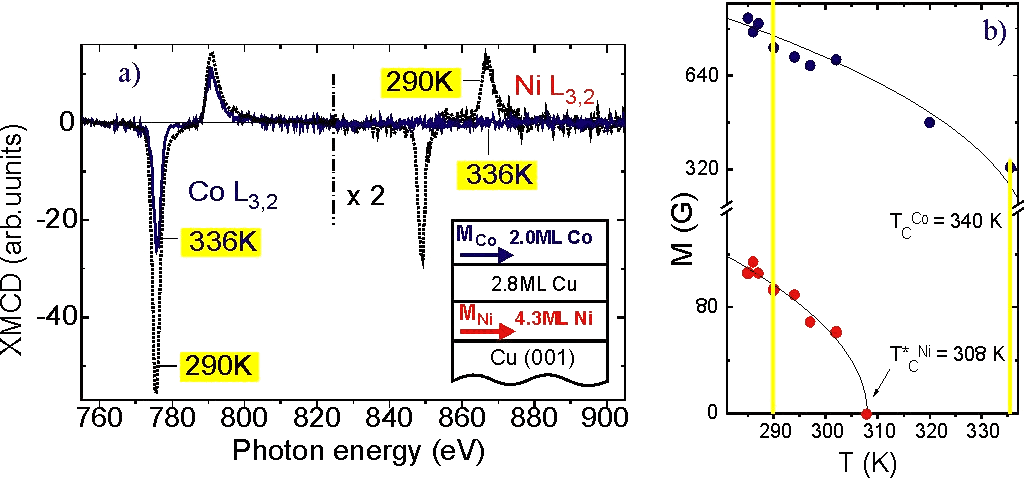
Fig. 4 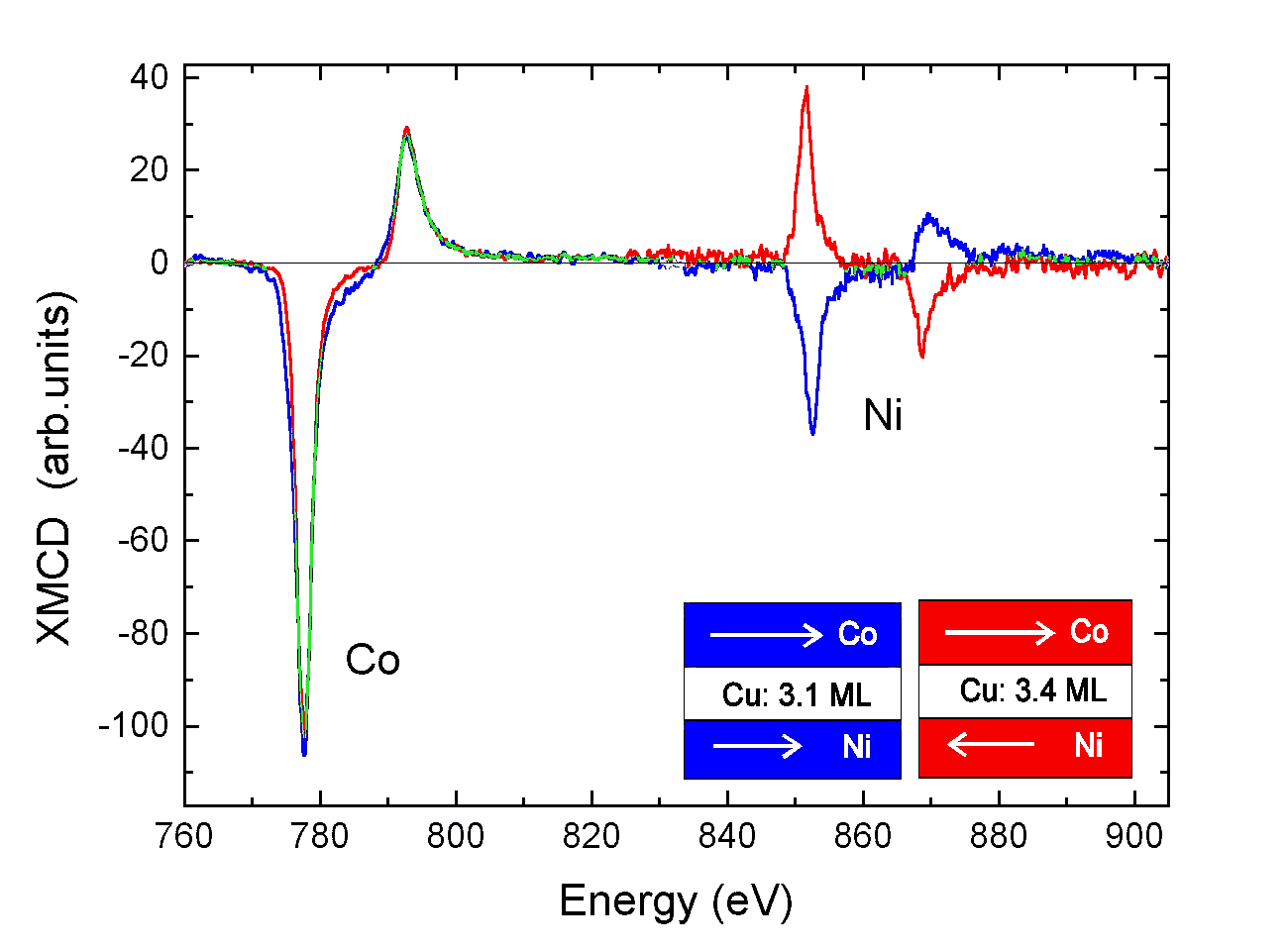
Figure 5 depicts element-specific remanent-magnetization curves for Ni and Coin bi- and trilayers. The Ni magnetization in the bilayer (open circles) vanishes at a temperature of about 270 K which corresponds to the temperature T CNi, since Ni is in-plane magnetized. After thedeposition of Co on the top of the Cu/Ni bilayer the temperature T*C Ni where the Ni magnetization (closed circles) vanishes is increased by DeltaTNi >>+40 K. The Co magnetization (closed diamonds), on the other hand, vanishes at much higher temperatures [Refs. 206,212,252] . The shift of the orderingtemperature of Ni has been understood by considering the reduced dimensionality of the Ni layers as it is explained in [Ref. 229] . Taking into account the oscillatory nature of Jinter with the spacer thickness d, one would expect a similar oscillation of the increase DeltaTNiwith d. Such a behavior is shown in Fig. 6 [Refs. 212,252] . The sign of DeltaTNi is always positive, implying that the ordering temperature of Ni is always increasing, independently of the FM or AFM coupling. The solidcurve in Fig. 6 is calculated with the theoretical parameters describing the two periods of oscillation of Jinter in an RKKY-like model and their experimental amplitude. Note the excellent agreement between the experimental data points and the theoretical curve without any adjustable parameter.
Fig. 5 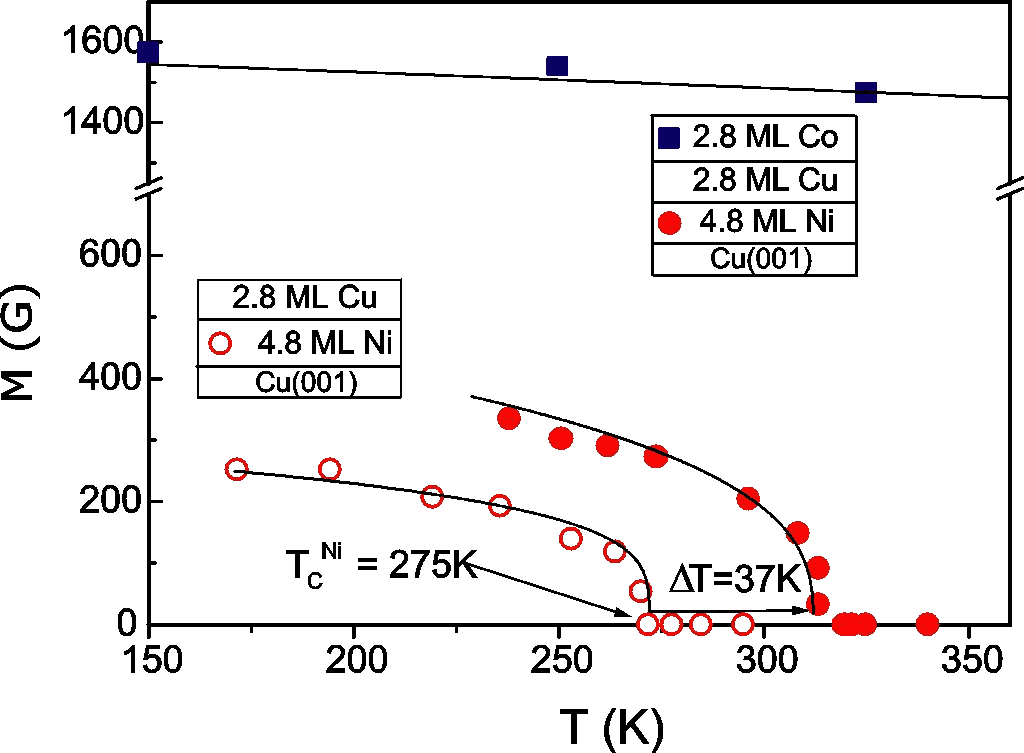
Fig. 6 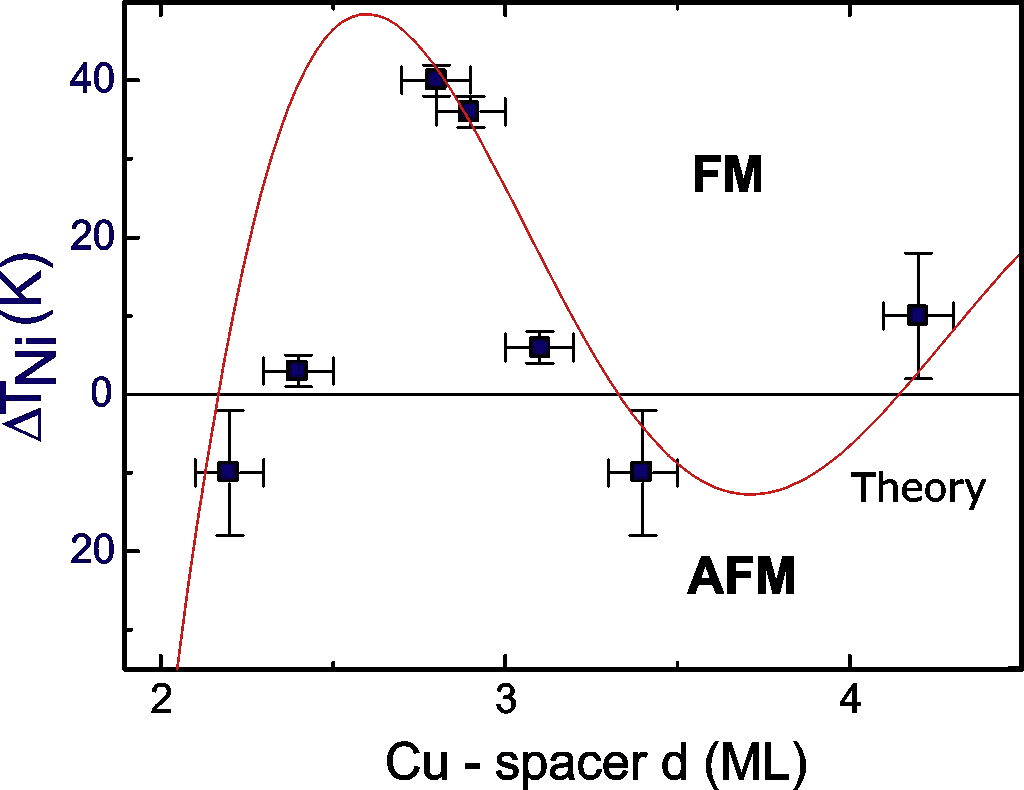
In Fig. 7 we present results from a trilayer where Co has lower Curietemperature than the Ni one. In Fig 7(a) we see the XMCD spectra at T=45K. Of particular interest is the large increase in the Ni XMCD before and after the evaporation of Co on the top. A clear picture of the magnetic behavior can be obtained from Fig. 7(b). First of all we see that the Co magnetization is larger than the Ni one at low temperatures and due to the low ordering temperature of Co the temperature-dependent magnetizations of Ni and Co cross each other just below 80 K. The peculiar shape of the Ni magnetization can be understood by the change of its easy axis due to the interlayer exchange coupling [Ref. 248] . This experiment demonstratesthat the coupling can be used for the fabrication of temperature-dependent magnetic switches, see also [Ref. 204] .
Fig. 9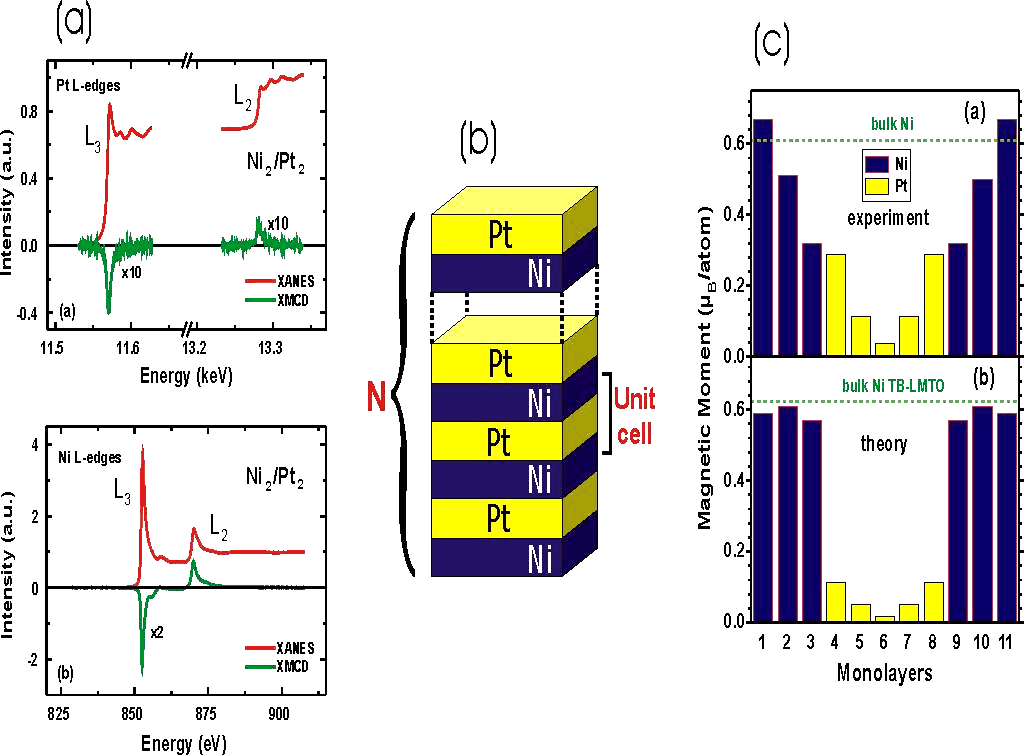
|
Fig. 10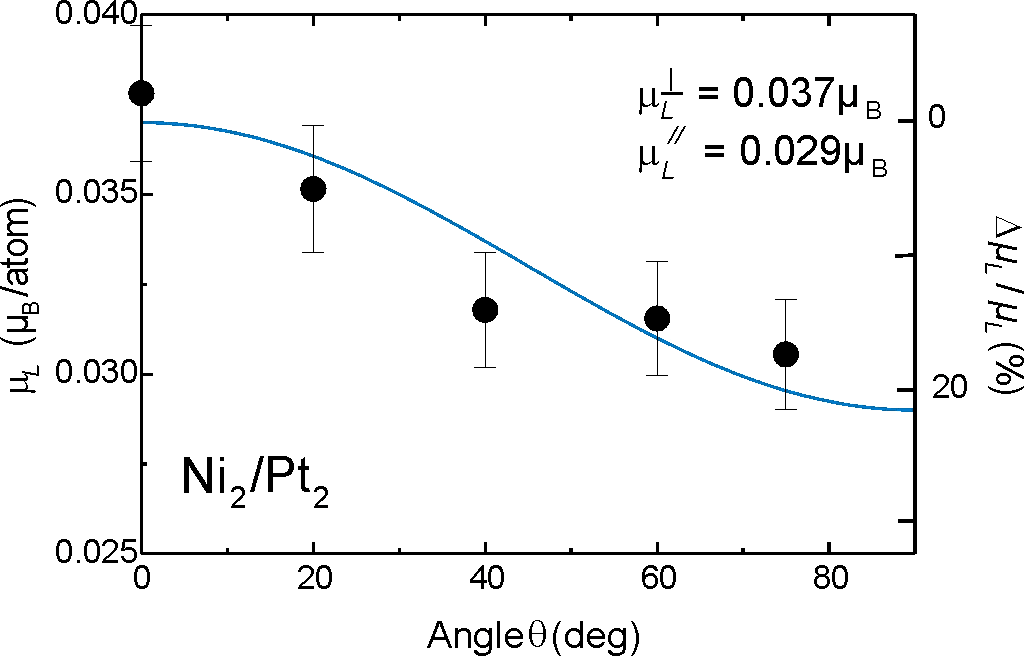
|
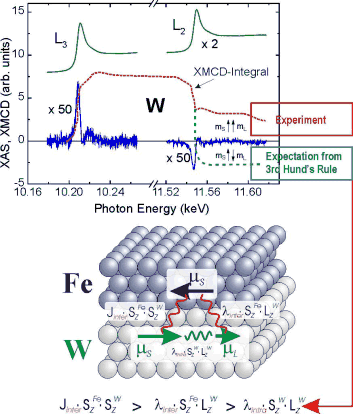 Fig. 11
Fig. 11